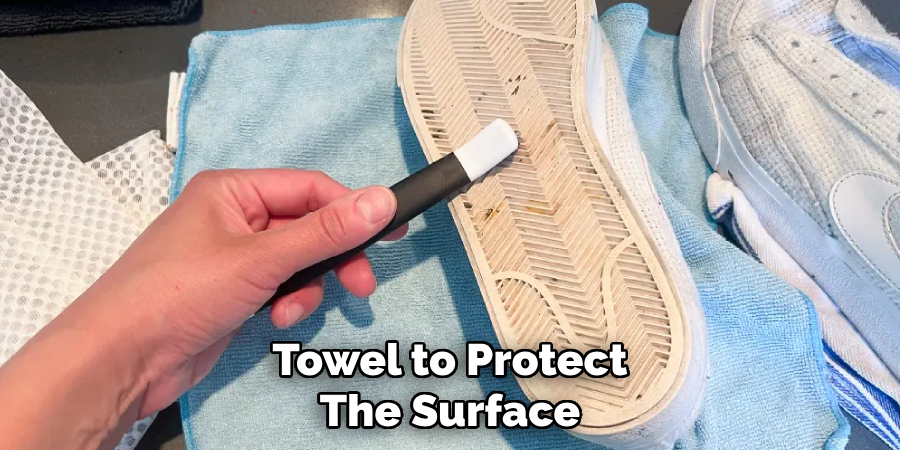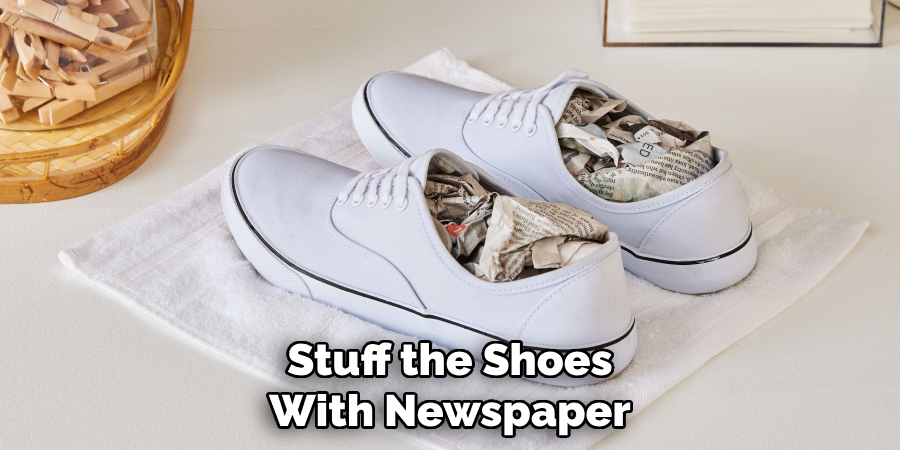Are you wondering how to eliminate that pungent mildew smell coming from your favorite pair of shoes?

Mildew on shoes can be both unsightly and damaging, as it not only affects the appearance of your footwear but can also lead to unpleasant odors and potential material deterioration. Whether caused by damp storage conditions or exposure to moisture, removing mildew from shoes is essential to preserve their quality and longevity. Fortunately, cleaning mildew off shoes with the right techniques and materials is a straightforward process. Additionally, taking preventive measures can help ensure that your shoes stay mildew-free.
This guide on how to remove mildew from shoes will walk you through effective methods to restore your shoes to their original condition while preventing future mildew growth.
What Are the Benefits of Removing Mildew From Shoes?
Before we dive into how to remove mildew from shoes, let’s first understand why it’s necessary. Here are some benefits of removing mildew from shoes:
- Improved Appearance: Mildew can leave unsightly stains and discoloration on your shoes, making them look old and worn out. Removing mildew can restore your shoes’ original appearance and keep them clean and fresh.
- Elimination of Odors: The musty smell that comes with mildew is unpleasant and difficult to get rid of. Removing mildew can eliminate any odors from your shoes and prevent them from returning.
- Prevention of Further Damage: If left untreated, mildew can cause the material of your shoes to deteriorate and weaken. By promptly removing mildew, you can prevent further damage and extend the lifespan of your shoes.
Once you understand the benefits of removing mildew from shoes, let’s move on to the methods you can use to do so effectively.
What Will You Need?
Before starting the cleaning process, make sure you have the following materials ready:
- White Vinegar: A natural disinfectant and deodorizer that is effective in killing mildew.
- Baking Soda: An excellent absorbent that helps remove moisture from your shoes.
- Soft-bristled Brush: This is used to scrub away mildew without damaging the material of your shoes.
- Clean Cloth/Towel: To remove excess moisture and residue from your shoes.
- Water: To rinse off any cleaning solutions and to dampen your shoes for certain methods.
Now that you have all the necessary materials, let’s start removing mildew from your shoes!
8 Easy Steps on How to Remove Mildew From Shoes
Step 1. Prepare Your Workspace:
Ensure that you set up your workspace in a well-ventilated area, preferably outdoors or near an open window, to minimize exposure to mildew spores and cleaning solution fumes. Lay down an old newspaper, a plastic sheet, or a towel to protect the surface you’ll be working on and to catch any residue or debris from the cleaning process.

Having a clean and organized workspace will make the process more efficient and prevent the spread of mildew to other areas or items. If you’re working indoors, consider wearing a mask to avoid inhaling mildew spores during cleaning.
Step 2. Remove Laces and Insoles:
Before cleaning, remove the laces and insoles from your shoes, if possible. This will allow you to clean each component thoroughly and prevent the spread of mildew to areas you might miss otherwise. Place the laces and insoles on your prepared workspace; they can be cleaned separately using the same methods or soaking them in a mild cleaning solution. Removing these parts ensures better access to hidden spots where mildew might be growing inside the shoes.
Step 3. Brush Off Loose Mildew:
Using a soft-bristle brush or an old toothbrush, gently brush off any visible mildew on the surface of your shoes. Do this in your prepared workspace to avoid spreading spores to other areas. Work carefully to avoid damaging delicate materials while focusing on seams, stitching, and crevices where mildew commonly accumulates. Dispose of any debris collected during this step in a sealed bag to prevent spores from spreading.
Step 4. Apply a Cleaning Solution:
Prepare a cleaning solution by mixing water and white vinegar or using a mild soap solution. Dampen a clean cloth or sponge with the solution and gently scrub the affected areas of your shoes. Pay extra attention to spots with visible mildew, ensuring thorough cleaning without oversaturating the material. For tougher stains, allow the solution to sit on the surface for a few minutes before scrubbing again. Once cleaned, wipe down the shoes with a separate cloth dampened with plain water to remove any residue.
Step 5. Dry Your Shoes Thoroughly:
After cleaning, it is crucial to dry your shoes completely to prevent further mildew growth. Place your shoes in a well-ventilated area, away from direct sunlight or heat sources that could damage the materials. If possible, stuff the shoes with newspaper or a clean, dry cloth to help absorb moisture and maintain their shape. Allow sufficient time for the shoes to air dry completely before wearing or storing them.

Step 6. Protect Your Shoes From Future Mildew:
Once your shoes are dry, take preventive measures to avoid mildew development in the future. Store your shoes in a cool, dry place with good air circulation, and consider using silica gel packets or shoe deodorizers to absorb excess moisture. Regularly clean and air out your shoes, especially after exposure to damp environments. Applying a waterproof spray or protective coating can also help repel moisture and reduce the risk of mildew forming on the surface.
Step 7. Regularly Inspect Your Shoes for Signs of Mildew:
To ensure your shoes remain in excellent condition, make it a habit to inspect them regularly for any signs of mildew or moisture buildup. Pay close attention to seams, insoles, and other areas prone to dampness. If you notice any early signs of mildew, address the issue immediately by cleaning and drying the shoes as outlined in the previous steps. Early intervention can prevent further damage and keep your shoes looking and smelling fresh.
Step 8. Use Proper Storage Solutions:
Storing your shoes correctly is critical to prevent mildew and prolong their lifespan. Avoid keeping them in plastic bags or airtight containers, as these can trap moisture and promote mildew growth. Instead, use breathable storage options, such as fabric shoe bags, open shelves, or shoe racks. For long-term storage, consider using cedar shoe trees to maintain the shape of your shoes and absorb any lingering moisture. Proper storage keeps your shoes mildew-free and helps them retain their form and functionality over time.

By following these simple steps, you can effectively remove mildew from your shoes and prevent its recurrence.
5 Things You Should Avoid
- Using Bleach or Harsh Chemicals: While bleach may seem like a quick solution, it can damage the material of your shoes, especially if they are made from delicate fabrics or leather. Instead, opt for gentler cleaning agents specifically designed for footwear.
- Skipping Protective Gear: Always wear gloves and, if necessary, a mask when dealing with mildew. Direct exposure to mildew can cause skin irritation or allergic reactions. Safety should be a priority when cleaning your shoes.
- Submerging Shoes in Water: Fully soaking your shoes in water may worsen the problem by adding excess moisture, which can promote further mildew growth. Use a damp cloth or a targeted cleaning method to protect your shoes from additional damage.
- Drying Shoes in Direct Heat: Avoid placing your shoes in direct sunlight or using high-temperature heat sources like hair dryers to dry them. Intense heat can cause cracking, shrinkage, or discoloration of your shoes’ material. Allow them to air dry in a well-ventilated space instead.
- Ignoring the Mildew Problem: Procrastinating or neglecting the issue can lead to more extensive mildew growth and a more pungent odor, potentially ruining your shoes beyond repair. Address mildew as soon as it appears to protect your footwear and maintain its quality.
What is the Difference Between Mold and Mildew?
Mold and mildew are fungi that can thrive in damp, dark environments. They reproduce by releasing spores into the air, spreading quickly if not addressed promptly. While these terms are often used interchangeably, they refer to different types of fungi and may require varying methods for cleaning and removal.
Mold usually appears as black or green fuzzy growth and is typically found on food or building materials like drywall or wood. Conversely, mildew is a white or gray powdery substance commonly seen on damp surfaces like fabrics or shoes.

Although mold can cause more severe health issues than mildew, both should be treated promptly to prevent further damage.
Conclusion
How to remove mildew from shoes is a straightforward process if addressed promptly. Begin by brushing off any loose mildew outdoors to prevent spores from spreading in your home. Next, clean the affected area with a mixture of warm water and mild detergent, using a soft brush or cloth to gently scrub the surface.
Applying a solution of equal parts water and white vinegar for stubborn mildew can be more effective. Allow the shoes to air dry thoroughly in a well-ventilated area, avoiding direct sunlight if the material is sensitive. To prevent mildew from returning, store your boots in a cool, dry place and consider using moisture-absorbing products such as silica gel packs or cedar shoe inserts.
Regular cleaning and maintenance will keep your footwear mildew-free and looking great.
About
Jennifer Branett is a distinguished figure in the world of Diy design, with a decade of expertise creating innovative and sustainable Diy solutions. His professional focus lies in merging traditional craftsmanship with modern manufacturing techniques, fostering designs that are both practical and environmentally conscious. As the author of diy, Jennifer delves into the art and science of furniture-making, inspiring artisans and industry professionals alike.
Education RMIT University
(Melbourne, Australia) Associate Degree in Design (Jennifer Branett) Focus on sustainable design, industry-driven projects, and practical craftsmanship. Gained hands-on experience with traditional and digital manufacturing tools, such as CAD and CNC software.
Nottingham Trent University
(United Kingdom) Bachelor’s in diyfastly.com and Product Design (Honors) Specialized in product design with a focus on blending creativity with production techniques. Participated in industry projects, working with companies like John Lewis and Vitsoe to gain real-world insights.
Publications and Impact
In diy, Jennifer Branett his insights on indoor design processes, materials, and strategies for efficient production. His writing bridges the gap between artisan knowledge and modern industry needs, making it a must-read for both budding designers and seasoned professionals.


